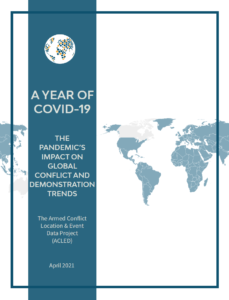The final report from our COVID-19 Disorder Tracker reviews ACLED’s special coverage of the pandemic’s impact on political violence and protest trends around the world over the past 12 months.
Introduction
March 2021 marks the first anniversary of the declaration of the COVID-19 pandemic by the World Health Organization (WHO). One year on, this report explores ACLED’s special coverage of the pandemic’s impact on political violence and protest trends around the world – analyzing changes in demonstration activity, state repression, mob attacks, overall rates of armed conflict, and more through the COVID-19 Disorder Tracker.
Earlier in the project we took stock of evolving political violence and protest patterns during the first 16 weeks of the crisis (see this ACLED report), and again after more than five months had passed (see this analysis for Foreign Policy). This report draws on a full year of data and analysis from ACLED’s COVID-19 Disorder Tracker to trace the pandemic’s wider effects on global disorder trends.
While demonstrations were initially interrupted as governments around the world implemented lockdowns and movement restrictions, protests ultimately resurged. Initially, this resurgence took the form of direct responses to government (mis)management of the pandemic and the immediate needs of protesters, including better access to personal protective equipment (PPE), or financial support amid the ensuing economic downturn. Soon thereafter demonstrations evolved into a continuation of the social movements that had begun prior to the crisis, with previously held grievances only exacerbated as a result of the pandemic’s economic fallout and government (mis)management. In other cases, new demonstration movements emerged altogether. The combined result is that demonstrations actually increased in 2020 relative to the year prior, not just despite — but in part because of — the pandemic.
As a global emergency, the pandemic offered unique opportunities — and cover — for those in power to institute a wide range of new restrictions and pass sweeping legislation. Some capitalized on the occasion to bolster their position and consolidate authority, contributing to democratic backsliding. Others selectively enforced legislation or restrictions as a means to stifle opposition and to limit any challenge to power. Overall, state repression increased around the world.
The pandemic has also had an array of both direct and indirect effects on conflict patterns. While many hoped that the crisis would spur ceasefires in many of the world’s conflicts, these hopes were largely dashed (see this report). Conflict events declined on aggregate compared to 2019, but political violence increased in more countries than it decreased, and most wars continued to rage (see this report). Rather, the coronavirus has contributed to shifting the incentive structures, opportunities, and timelines of conflict actors. In some cases, violence increased as groups seized the opportunity to ramp up their activity, especially at a time when state forces were preoccupied with the health crisis. In other cases, non-state groups, vying for greater legitimacy, tried to buy the support of local populations through ‘better governance’ of the pandemic than their state adversaries. In some countries, the effects of the pandemic indirectly resulted in increasing competition among armed groups, while in others, previously competing armed groups coalesced around opposition to government response to the pandemic. Yet in others still, the coronavirus disrupted the political landscape, exacerbating long-simmering tensions.
A year on, this report marks the end of our special COVID-19 Disorder Tracker coverage, reviewing the dozens of spotlight pieces and special reports compiled by the ACLED team during the course of the project. Together, these pieces help to paint a picture of the myriad ways in which the pandemic has impacted global disorder trends over the past year.






